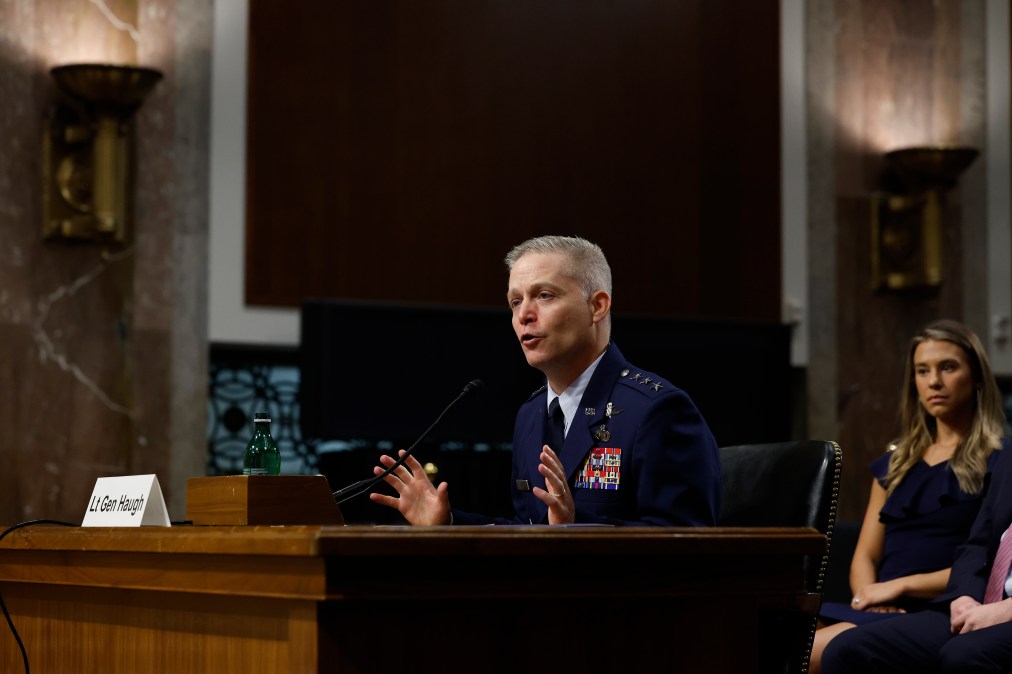Cybercom-NSA nominee argues severing dual hat would be ‘time consuming, more complex and less effective’

President Biden’s pick to lead U.S. Cyber Command and the National Security Agency believes both jobs are not only not too much for a single individual to handle, but dismantling the so-called dual-hat arrangement “would be more time consuming, more complex and less effective.”
“Fracturing the current USCYBERCOM-NSA command arrangement would degrade flexibility, adaptability, and speed of action now provided through close and interconnected processes; ultimately impacting mission outcomes,” Lt. Gen. Timothy Haugh wrote to members of the Senate Armed Services Committee in a questionnaire as part of his confirmation process.
The phrase “dual hat” refers to Cybercom and NSA sharing a boss. When Cybercom was first created a decade ago, it was co-located with NSA at Fort Meade, Maryland to help the nascent command grow, relying on the personnel, expertise and infrastructure of the NSA. The arrangement was initially expected to be temporary.
Opponents say the dual-hat arrangement is too much work for a single person and relying on the intelligence community’s tools — which are meant to stay undetected — for military activities poses risks to such espionage activity.
Haugh said the demands of each position are effectively managed and aren’t excessive for one individual.
There has been a burgeoning consensus in Washington that the two organizations have grown closer and might never split as officials have maintained the critical intelligence NSA provides helps feed Cybercom’s operations. Haugh noted in his confirmation hearing before the Senate Intelligence Committee July 12 that “the overlap between activities in cyberspace and within signals intelligence, those things are inextricably linked.”
To date, many officials — including the findings of a conducted by a Defense Department and intelligence community steering group, led by former Chairman of the Joint Chiefs Joseph Dunford — have simply noted that the dual-hat arrangement is in the best interest of the United States.
However, Haugh, who is currently Cybercom’s deputy commander, went further, telling lawmakers that severing NSA and Cyber Command leadership would be problematic.
“The signals intelligence and cyber operating environments substantially overlap. Eliminating the dual hat would reduce relevant visibility and understanding across both mission sets, increasing risk to intelligence sources and operational activities,” Haugh wrote. “It would reduce the speed and effectiveness of cybersecurity collaboration in the protection of National Security Systems (NSS), the [DOD Information Network], and the [defense industrial base] by slowing and complicating information sharing and work with overlapping partners. Finally, ending the dual hat would complicate relationships with Allies and partners that conduct their own signals intelligence and cyberspace operations.”
Haugh told senators Thursday during his confirmation hearing before the Senate Armed Services Committee that having worked on each side of both organizations, “how we partner and be able to take the guidance from a single leader becomes effective in our response so we can move with the speed and agility today” — and it “would be very difficult to replicate [that] in a different configuration.”
‘Call balls and strikes’
One of the biggest arguments for keeping the current arrangement is having a single person at the top of both organizations that has oversight over the operations and activities of each.
Given the sensitivities and competing interests involved between espionage — which aims to burrow into systems and avoid detection for continued intel collection — and warfighting — which involves disrupting or destroying systems — some have argued for the need of a single person to weigh in on these equities.
“I think if you did not have a dual-hat arrangement … you would have two separate bureaucracies who would clash on a daily basis about the use of the tools, about the coordination of efforts, about the protection of their own silos,” Sen. Mike Rounds, R-S.D., ranking member of the Senate Armed Services Subcommittee on Cybersecurity, has said. “I think you have to have a person on top who can call balls and strikes between the two separate organizations.”
This so-called intelligence gain/loss, some argue, is essentially why there needs to be a single person in charge of each organization, rather than risk reducing speed of action and oversight by splitting leadership roles and adding more bureaucracy.
“This is perhaps the most critical advantage of the dual hat — a single decision maker, responsible and accountable for the mission outcomes of both organizations, is best equipped to protect critical intelligence equities while executing national priorities, as directed. It ensures fully informed tradeoff decisions are made under accountability to both the Secretary of Defense and Director of National Intelligence,” Haugh wrote.
“The most positive aspect of the dual hat is the ability of a single decision maker, responsible for the separate and distinct mission outcomes of both organizations, to allocate resources, set priorities, and execute complementary actions to produce critical outcomes for the nation. It ensures that a single, fully informed decision maker is able to protect our nation’s most sensitive signals intelligence equities and ensure both organizations are aligned with the nation’s priorities,” he added.
It is unclear when Haugh might be confirmed and take over for the retiring Gen. Paul Nakasone because Alabama Republican Sen. Tommy Tuberville has put a blanket hold on senior military officer confirmations in protest of the DOD’s abortion policies.






